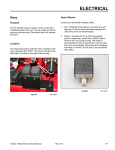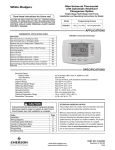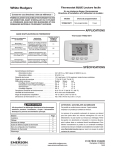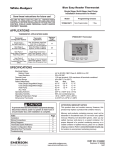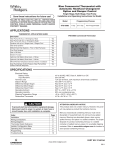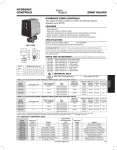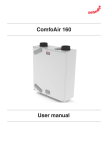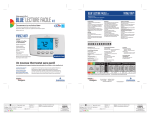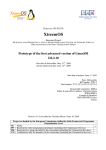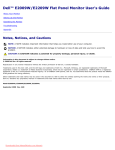Download White Rodgers 1F95EZ-0671 Thermostat User Manual
Transcript
Blue Easy Reader Thermostat Single Stage, Multi-Stage, Heat Pump Installation and Operating Instructions for Model: Save these instructions for future use! FAILURE TO READ AND FOLLOW ALL INSTRUCTIONS CAREFULLY BEFORE INSTALLING OR OPERATING THIS CONTROL COULD CAUSE PERSONAL INJURY AND/OR PROPERTY DAMAGE. Model Programming Choices 1F95EZ-0671 Non-Programmable 7 Day APPLICATIONS THERMOSTAT APPLICATION GUIDE 1F95EZ-0671 Thermostat Maximum Stages Heat/Cool Thermostat Configuration Options Thermostat Applications Single Stage 1 No Heat Pump (SS1) Multi Stage 2 No Heat Pump (MS2) Gas, Oil, Electric, Heat Only, Cool Only or Heat/Cool Systems, 2 or 3 wire Hydronic Zone (Hot Water or Steam) Systems, 24 Volt or Millivolt Heat Pump 1 Single Stage Compressor Heat Pump (HP1) Single Stage Compressor Heat Pump Systems - up to 2 Stages Aux./Emergency Heat 3/1 Heat Pump 2 Two Stage or Two Compressor Heat Pump (HP2) Two Stage or Two Compressor Heat Pump systems - up to 2 Stages Aux./Emergency Heat 4/2 1/1 2/2 SPECIFICATIONS Electrical Rating: Battery Power . . . . . . . . . . . . . . . . . . . . . . . . . . Input-Hardwire . . . . . . . . . . . . . . . . . . . . . . . . . Terminal Load . . . . . . . . . . . . . . . . . . . . . . . . . . . . . Setpoint Range . . . . . . . . . . . . . . . . . . . . . . . . . . . . Differential (Single Stage) . . . . . . . . . . . . . . . . . . . . Differential (Multi-Stage) . . . . . . . . . . . . . . . . . . . . . Differential (Heat Pump) . . . . . . . . . . . . . . . . . . . . . Operating Ambient. . . . . . . . . . . . . . . . . . . . . . . . . . Operating Humidity . . . . . . . . . . . . . . . . . . . . . . . . . Shipping Temperature Range . . . . . . . . . . . . . . . . . Dimensions Thermostat. . . . . . . . . . . . . . . . . . . . . . ! CAUTION To prevent electrical shock and/or equipment damage, disconnect electric power to system at main fuse or circuit breaker box until installation is complete. Index Installation Wiring Connections Wiring Diagrams Thermostat Quick Reference Installer Configuration Menu Operating Your Thermostat Troubleshooting Page 2 2 3 4 5 7 8 mV to 30 VAC, NEC Class II, 50/60 Hz or DC 20 to 30 VAC 1.5A per terminal, 2.5A maximum all terminals combined 45 to 99°F (7 to 32°C) Heat 0.6°F; Cool 1.2°F Heat 0.6°F; Cool 1.2°F Heat 1.2°F; Cool 1.2°F 32°F to +105°F (0 to +41°C) 90% non-condensing max. -40 to +150°F (-40 to +65°C) 4.2"H x 6.4"W x 1.7"D ATTENTION: MERCURY NOTICE This product does not contain mercury. However, this product may replace a product that contains mercury. Mercury and products containing mercury must not be discarded in household trash. Do not touch any spilled mercury. Wearing non-absorbent gloves, clean up any spilled mercury and place in a sealed container. For proper disposal of a product containing mercury or a sealed container of spilled mercury, place it in a suitable shipping container. Refer to www.white-rodgers.com for location to send product containing mercury. www.white-rodgers.com PART NO. 37-6986A 0846 INSTALLATION ! WARNING Thermostat installation and all components of the control system shall conform to Class II circuits per the NEC code. Remove Old Thermostat Before removing wires from old thermostat, mark wires for terminal identification so the proper connections will be made to the new thermostat. Installing New Thermostat 1. Pull the thermostat body off the thermostat base. Forcing or prying on the thermostat will cause damage to the unit. 2. Place base over hole in wall and mark mounting hole locations on wall using base as a template. 3. Move base out of the way. Drill mounting holes. If you are using existing mounting holes and the holes drilled are too large and do not allow you to tighten base snugly, use plastic screw anchors to secure the base. 4. Fasten base snugly to wall using mounting holes shown in Figure 1 and two mounting screws. Leveling is for appearance only and will not affect thermostat operation. 5. Connect wires to terminal block on base using appropriate wiring schematic. 6. Push excess wire into wall and plug hole with a fire resistant material (such as fiberglass insulation) to prevent drafts from affecting thermostat operation. 7. Carefully line the thermostat up with the base and snap into place. Thermostat Power Method Switch Position/Description Battery Powered, no 24 Volt system power available. Switches "On", thermostat runs on batteries. Hardwired with Battery Back-up, for 24 Volt systems with common connection from transformer to "C" terminal on thermostat. Switches "On", thermostat runs on power directly from transformer with battery backup. *Battery Powered with Power Stealing Assist, for 24 Volt systems with no common connection from transformer to "C" terminal on thermostat. Switches "On", thermostat runs on batteries and supplemental power drawn through the heat or cool circuit. *Power Stealing Assist is very reliable to increase battery life, but on a small number of heating or cooling systems with high impedance electronic modules you may observe one of the following conditions: 1. The furnace draft inducer motor may run with no call for heat. 2. The furnace fan may turn on with no call for heat or may not turn off. 3. The furnace may not turn off when the call for heat ends. 4. The air conditioner may not turn off when the call for cool ends. If the Power Stealing Assist method is not compatible with your system, place the Power Stealing Switches to "Off". This cancels Power Stealing Assist, operates the thermostat on batteries and corrects the condition. Figure 1 – Thermostat Base Multi-Stage 1F95EZ-0671 Battery Location 2 "AA" alkaline batteries are included in the thermostat at the factory with a battery tag to prevent power drainage. Remove the battery tag to engage the batteries. To replace batteries, set system to OFF, remove thermostat from wall and install the batteries in the rear along the top of the thermostat (see Figure 1). For best results, use a premium brand "AA" alkaline battery such as Duracell® or Energizer®. If the home is going to be unoccupied for an extended period (over 3 months) and is displayed, the batteries should be replaced before leaving. Mounting Hole Mounting Hole Place Level across Mounting Tabs (for appearance only) Place Level across Mounting Tabs (for appearance only) Rear view of thermostat Power Stealing Switch The Power Stealing Switches (Fig. 1) should be left in the "On" position for most systems. The information in the following table details the thermostat power method and switch options. WIRING CONNECTIONS Refer to equipment manufacturers' instructions for specific system wiring information. After wiring, see CONFIGURATION section for proper thermostat configuration. Terminal Designation * 2 "AA" Batteries Power Stealing Switches * A1 For Damper Control Not Applicable To This Model. Wiring diagrams shown are for typical systems and describe the thermostat terminal functions. TERMINAL DESIGNATION DESCRIPTIONS Description O/B ............................... Changeover valve for heat pump energized constantly in cooling and off/heating Y2 ............................... 2nd Stage Compressor Y ............................... Compressor Relay G ............................... Fan Relay RC ............................... Power for Cooling RH ............................... Power for Heating C ............................... Common wire from secondary side of cooling (Optional). Required for fault indication, continuous backlight operation or remote temperature sensor operation 6 Powered closed 3rd wire for 3-wire zone valve W/E ................................Heat Relay/Auxiliary Heat Relay (Stage 1) (3rd Stage Heat in HP2) W2 ............................... 2nd Stage Heat (4th Stage Heat in HP2) L ............................... Compressor diagnostic indicator for systems with diagnostic connection typically found on Heat pump systems or with Copeland's Comfort Alert 2 WIRING DIAGRAMS Single Stage, Multi-Stage and Heat Pump Connections Figure 2 – Single Stage or Multi-Stage System (No Heat Pump) with Single Transformer Refer to equipment manufacturers' instructions for specific system wiring information. Jumper L Y O/B G W2 W/E Y2 RH C RC 6 This thermostat is designed to operate a single-transformer or two-transformer system. System O Single Stage 1 (SS1) Diagnostic Energized Constantly Indicator in Input Cool Mode Cool Mode or 1st Stage System B Malfunction Energized Constantly Switch in Heat, Off, Input Emergency Mode MultiStage 2 (MS2) Blower/ Circulator Fan Energized on Call for Cool (and Heat if configured for Electric Heat) No Output No Heat Output Mode 1st Stage Cool Heat Mode Mode 2nd Stage 2nd Stage You can configure the thermostat for use with the following systems: 24 Volt 24 Volt Optional* 24 Volt (Hot) (Hot) (ComHeat Cool mon) SINGLE STAGE (SS 1) gas, oil or electric. MULTI-STAGE (MS 2) gas, oil or electric. Comfort Alert II Module or Similar System Diagnostic Module HEAT PUMP TYPE 1 (HP 1). Single stage NEUTRAL 120VAC 24VAC HOT See Module Instructions for details compressor or two compressor system with gas or electric backup. * Common connection required for diagnostic or malfunction indication. Figure 3 – Single Stage or Multi-Stage System (No Heat Pump) with Two Transformers Y2 Y O/B G W2 W/E RH After wiring, see INSTALLER CONFIGURATION section for proper thermostat configuration. Remove Jumper Wire between RH & RC Jumper L compressor system; gas or electric backup. HEAT PUMP TYPE 2 (HP 2). Multi-stage CLASS II TRANSFORMER RC C System O Single Stage 1 (SS1) Diagnostic Indicator (Optional) MultiStage 2 (MS2) Energized Constantly in Cool Mode B Energized Constantly in Heat, Off, Emergency Mode No Output No Heat Cool Mode Output Mode 1st Stage 1st Stage Heat Mode Cool 2nd Stage Mode 2nd Stage Blower/ Circulator Fan Energized 24 Volt 24 Volt Optional* on Call for 24 Volt (Hot) (Hot) Cool (and (ComHeat Cool Heat if mon) configured for Electric Heat) NEUTRAL 120VAC 120VAC 24VAC NEUTRAL HOT 24VAC COOLING HOT CLASS II TRANSFORMER HEATING CLASS II TRANSFORMER * Common connection required for diagnostic or malfunction indication. Figure 4 – Heat Pump Systems Jumper L Y O/B Y2 + + W/E W2 G RH C RC 6 System Heat Mode - 2nd Heat Mode - 3rd Stage, Emergency Stage, Emergency Mode - 1st Stage Mode - 2nd Stage Blower/ No Circulator Fan Optional* Output Energized on Diagnostic Heat and Call for Heat 24 Volt 24 Volt 24 Volt Indicator Cool Mode (Hot) (Hot) (Comor Cool. B or System 1st Stage Heat Mode-4th Heat Mode - 3rd Heat Cool mon) Set Elect/Gas 2nd Energized in Malfunction (Compressor) Stage, Emergency Stage. Emergency Stage Heat, Off, Switch Mode - 1st Stage Mode - 2nd Stage Option for + (ComNote: Dual Fuel option +Note: Dual Fuel option Emergency Emergency Heat mode de-energizes Heat mode mode pressor) de-energizes Mode stage 1 (compressor) stage 1 (compressor) O Heat Pump 1 (HP1) + Note: Dual Fuel option +Note: Dual Fuel option de-energizes Heat mode de-energizes Heat mode stage 1 (compressor) stage 1 (compressor) when auxiliary heat when auxiliary heat is energized is energized Energized in Cool Mode Heat Pump 2 (HP2) when auxiliary heat is energized when auxiliary heat is energized Comfort Alert II Module or Similar System Diagnostic Module NEUTRAL 120VAC 24VAC See Module Instructions for details HOT CLASS II * Common connection required for diagnostic or malfunction indication. + Dual Fuel option, if selected turns off compressor(s) when Auxiliary stages energize. Figure 5 – 3-Wire (SPDT) Heat Only Zone Valve Wiring Jumper 6 Y W G Opens Valve (4) Blower/Circulator Fan Energized RH RC C System Single Stage 3-wire Zone Valve application Constant Closes Valve (6) 24 Volt 24 Volt (Hot) (Hot) Cool Heat (5) 24 Volt (Common) NEUTRAL 120VAC 24VAC HOT CLASS II TRANSFORMER 3 THERMOSTAT QUICK REFERENCE Home Screen Description Figure 6 – Home Screen Display Room Temperature Setting Temperature Battery Level Indicator Indicating the current power level of the 2 “AA” batteries. Full power remaining. Half power remaining. Change The batteries should be replaced at this time with 2 new premium brand “AA” Alkaline batteries. (See page 2 for more details). System Indicators Fan Indicator Figure 7 – Programming & Configuration Items 13 12 11 10 14 15 9 16 8 17 7 6 1 2 3 4 5 Programming and Configuration Items 1 “Heat" “A/C” “Off” identifies button. When filled indicates system mode selected. 2 "Aux" inidicates thermostat configured for Heat Pump. When filled indicates Auxiliary stage is operating. 3 "Adv Day" identifies button when in schedule mode. 10 "Setting" indicates the setpoint temperature. 11 "Hold Temp" indicates temporary hold or "Hold" indi- cates hold mode. 12 "Morn" "Day" "Eve" "Night" indicates period being programmed or current program in Run mode. 4 "Time" identifies button when in schedule mode. 13 "A" "P" indicates time as Morning (A) or Evening (P). 5 "Fan" identifies button. When filled indicates Fan is on. 14 "Mon - Sun" indicates day of week. 6 "Run" identifies button to begin normal operation. 15 "Month" "Year" "Date" indicates the Month Year or 7 "Sched" identifies button to be used during programming or "Run Sched" identifies button to return to normal operation. 8 "Hold" "Copy" "Menu" identifies button. 9 "Limit" indicates temperature is adjusted to the limit set in the configuration menu. 4 Date when setting time. 16 "Call For Service" indicates a diagnostic fault in the heating/cooling system. It does not inidicate a fault in the thermostat. 17 "Change" indicates when batteries are low and should be replaced. INSTALLER/CONFIGURATION MENU With Heat or A/C selected, press and hold the Menu button for at least 5 seconds. The display will show item #1 in the table below. Press Menu to advance to the next menu item. Press or to change a menu item options. INSTALLER/CONFIGURATION MENU Menu HP SS Ref. Press Button Displayed (Factory Default) Press or to select from listed options Comments 1 1 1 MENU (MS 2) HP 1, HP 2, SS 1 Selects Multi-Stage (MS 2 No Heat Pump), Heat Pump 1 (HP 1, 1 compressor), Heat Pump 2 (HP 2, 2 compressor or 2 speed compressor), or Single Stage (SS 1) 2 2 2 MENU (GAS) for SS or MS ELE GAS setting: furnace controls the blower ELE setting: thermostat controls the blower 3 3 3 MENU E (On) OFF Selects Energy Management Recovery (EMR) On or OFF. (Not available in -non-programmable mode) 4 – 4 MENU CR Heat (ME) SL, FA Selects Adjustable Anticipation, cycle rate, Heat (This item only appears when MS 2 or SS 1 is selected above) 5 4 – MENU CR Heat A/C (ME) SL, FA Selects Adjustable Compressor Anticipation (Heat Pump) This item only appears when HP 1, HP 2 is selected above 6 5 5 MENU CR A/C (ME) or CR Aux Heat (FA) SL, FA Selects Adjustable Anticipation, cycle rate, cool (when MS 2 or SS 1 is selected above.) or Selects the cycle rate for Auxiliary stage (when HP 1 or HP 2 is selected above) SL 7 6 6 MENU CL (OFF) CL On Compressor Lockout Time 8 7 7 MENU Heat A/C Off or Aux Heat A/C Off Heat A/C Off, Heat Off with Fan icon, Heat Off without Fan icon A/C Off System Mode Configuration with Automatic Changeover capability 9 8 8 MENU CO (OFF) CO On Selects Compressor Optimization 10 9 9 MENU dL (On) dL OFF Selects Display Light On or OFF 11 10 10 MENU 0 HI (current temperature) 1 HI, 2 HI, 3HI, 4 HI, 1 LO, 2 LO, 3 LO, 4 LO Adjustable Ambient Temperature Display 12 11 11 MENU °F °C Selects Fahrenheit/Celsius Temperature Display 13 12 12 MENU P (0) 7 Defaults to P (0) non-programmable P (7) is 7-day programming 14 13 13 MENU PS (2) 4 Selects Program periods per day: 4 = Morn, Day, Eve, Night 2 = Day, Night 15 14 – MENU Heat FA (On) OFF Fast Heat option may be disabled by selecting OFF. NA to SS or HP1 config. 16 15 14 MENU A/C FA (On) OFF Fast Cool option may be disabled by selecting OFF. NA to SS or HP1 config. 17 16 15 MENU dS (On) Off Selects Automatic Daylight Saving Time option 18 17 16 MENU HL Heat (99) 62 to 98 Select's Limited HEAT Range 19 18 17 MENU LL A/C (45) 46 to 82 Select's Limited A/C Range 20 19 – MENU dF (0) 1 to 9 Selects dF (dual Fuel) setting. 0 is Off (If dual Fuel option is required, a selection of 5 is recommended) MENU Cd (60) 0 to 99 Selects compressor delay in seconds when dF is greater than 0 MENU A/C On (o) Heat On (b) Selects operation of the reversing valve terminal (O/B) output as an O or B terminal 21 20 18 5 INSTALLER/CONFIGURATION MENU 1) This control can be configured for: MS 2 – Multi-Stage System (no heat pump) HP 1 – Heat Pump with one stage of compressor HP 2 – Heat Pump with two stage compressor or two compressor system, Gas or Electric backup SS 1 – Single Stage System 2) GAS or Electric (ELE) fan operation. If the heating system requires the thermostat to energize the fan, select ELE. Select GAS if the heating system energizes the fan on a call for heat. 3) Energy Management Recovery: (this step is skipped if configured to be non-programmable). Energy Management Recovery (E) On enables the thermostat to start heating or cooling early to make the building temperature reach the program setpoint at the time you specify. Heating will start 5 minutes early for every 1° of temperature required to reach setpoint. Example: E On is selected and your heating is programmed to 65° at night and 70° at 7 AM. If the building temperature is 65°, the difference between 65° and 70° is 5°. Allowing 5 minutes per degree, the thermostat setpoint will change to 70° at 6:35 AM. Cooling allows more time per degree, because it takes longer to reach set temperature. 4, 5 & 6) Cycle Rate Selection – The factory default setting for Heat and Cool modes, SS1, MS2, is medium cycle (ME). For Heat Pump, HP1, HP2, the default setting is medium (ME). For Aux the default setting is fast cycle (FA). To change cycle or button. rate, press the Cycle rate differentials for different settings are: MODE Fast FA Medium Slow ME SL Heat (SS1, MS2) Cool (SS1, MS2) Heat Pump (HP1, HP2) AUX (HP1, HP2) 0.4°F 0.9°F 0.9°F 0.6°F 0.6°F 1.2°F 1.2°F - 1.7°F 1.7°F 1.7°F 1.7°F 7) Select Compressor Lockout CL OFF or ON – Selecting CL ON will cause the thermostat to wait 5 minutes between cooling cycles. This is intended to help protect the compressor from short cycling. Some newer compressors already have a time delay built in and do not require this feature. Your compressor manufacturer can tell you if the lockout feature is already present in their system. When the thermostat compressor time delay occurs, it will flash the setpoint for up to five minutes. 8) System Mode Configuration – This thermostat is configured for Heat and Cool (SYSTEM switch with Cool Off Heat) default. It can also be configured for Heat and Cool (Heat, Cool, Off), Heat only with fan (Off Heat), Heat only without fan, and Cool only (Cool Off). 9) Compressor Optimization – CO provides a delay in circulator fan operation after the compressor turns on or off. With CO selected ON, when the compressor turns on (for a call for heat in heat pump or a call for cool) the fan will be delayed for five seconds before turning on to allow the air to be heated or cooled. After the compressor turns off for call for cool, the fan will continue to run for 20 seconds to circulate all of the cooled air. If CO is set to OFF, there will be no delay in fan operation. 10) Select Backlight Display – The display backlight improves display contrast in low lighting conditions. When the "C" terminal is powered, selecting backlight dL ON will keep the light on continuously. Select backlight OFF will turn the light on momentarily after any button is pressed. When the "C" 6 terminal is not powered, the light will be on momen- tarily after any button is pressed no matter whether the backlight is selected ON or OFF. 11) Select Temperature Display Adjustment 4 LO to 4 HI – Allows you to adjust the room temperature display up to 4° higher or lower. Your thermostat was accurately calibrated at the factory, but you have the option to change the display temperature to match your previous thermostat. The current or adjusted room temperature will be displayed. 12) Select F° or C° Readout – Changes the display readout to Celsius or Fahrenheit as required. 13) Program Options: Selects configuration for 7 day (7) or non-programming (0) mode. The default setting is 0, indicating non-programming. The programs per week can be or buttons. A selection changed by pressing the of 0 days for non-programmable will eliminate the need for EMR, and that step in the menu will be skipped. 14) Program Steps per day – This control can be configured for 4 or 2 program steps per day. Default is "PS" and can be toggled between 4 PS and 2 PS. 15 & 16) Select Fast Second Stage ON or OFF – Heat pump or Multi-stage only, in the run mode, with the fast Heat feature enabled (FA Heat On), if the Heat setpoint temperature is manually raised by 3°F (2°C) or more the second stage above the actual temperature using will energize immediately. With FA OFF, second stage will not energize until the setpoint temperature is 1°F or more above actual temperature for more than ten minutes. The Fast Cool feature (FA Cool) provides the same controls when the setpoint temperature is lowered. 17) Select Daylight Saving Time Calculation – This feature will allow the thermostat to calculate the DST automatically and apply it to the Real Time Clock display. Default or touch keys to select the feature OFF. On. Use 18) Limited Heat Range – This feature provides a maximum setpoint temperature for heat. The default setting is 99°F. It can be changed between 62°F and 98°F by pressing the or button. 19) Limited Cool Range – This feature provide a minimum setpoint temperature for cool. The default setting is 45°F. It can be changed between 46°F and 82°F by pressing the or button. 20) Select Dual Fuel (dF) – Selects dual fuel setting 0 to 9 (0 is default OFF, for Elect AUX) if your system has a fossil fuel (gas or oil) Auxiliary heat. HP1 or HP2 only. Select Compressor Delay (Cd) – After the auxiliary heat is turned on, the compressor(s) shut down is delayed for the time selected (in seconds). This delay is factory set or to 60, but can be set in the range of 0 to 99 using buttons. Available only if dF 1 to 9 is selected above. 21) Select Reversing Valve Output – The O/B option is factory set at "O" position. This will accommodate the majority of heat pump applications, which require the changeover relay to be energized in COOL. If the thermostat you are replacing or the heat pump being installed with this thermostat requires a "B" terminal, to energize the changeover relay in HEAT, the O/B option should be set at "B" position. OPERATING YOUR THERMOSTAT Check Thermostat Operation NOTE To prevent static discharge problems, touch side of thermostat to release static build-up before touching any keys. ! CAUTION To prevent compressor and/or property damage, if the outdoor temperature is below 50°F, DO NOT operate the cooling system. Cooling System If at any time during testing your system does not operate properly, contact a qualified service person. Fan Operation If your system does not have a G terminal connection, skip to Heating System. 1. Turn on power to system. 2. Press FAN button. The display will show "Fan" and the blower should begin to operate. 3. Press FAN button again. The display will show "Fan" outlined and the blower should stop immediately. 1. Press A/C button to select A/C. 2. Press to adjust thermostat setting below room temperature. The blower should come on immediately on high speed, followed by cold air circulation. The display should show “A/C”. If the setpoint temperature display is flashing, the compressor lockout feature is operating (see Configuration menu, item 7). 3. Adjust temperature setting to 3° below room temperature. The second stage cooling should begin to operate. A click from the thermostat will be heard to confirm second stage. 4. Press to adjust the temperature setting above room temperature. The cooling system should stop operating. ! CAUTION Do not allow the compressor to run unless the compressor oil heaters have been operational for 6 hours and the system has not been operational for at least 5 minutes. Heating System 1. Press the HEAT button to select HEAT. If the auxiliary heating system has a standing pilot, be sure to light it. 2. Press to adjust thermostat setting to 1° above room temperature. The heat pump system should begin to operate. The display should show “Heat”. However, if the system configuration is set to HP1 or HP2 and setpoint temperature display is flashing, the 5 minute compressor lockout feature is operating (see Configuration menu, item 7). 3. Adjust temperature setting to 3° above room temperature. If your system configuration is set at MS2, HP2 or HP1, the auxiliary heat system should begin to operate and the display will show "Aux" and "Heat". 4. Press to adjust the thermostat below room temperature. The heating system should stop operating. Auxiliary (Emergency) System AUX bypasses the Heat Pump to use the heat source wired to terminal W/E on the thermostat. AUX is typically used when compressor operation is not desired, or you prefer back-up heat only. Dual Fuel Temperature Setpoint and Compressor Delay When the thermostat is configured for Heat Pump mode and the Dual Fuel feature is selected, the thermostat can use software logic to determine when to switch to gas heat and shut down the compressor. This eliminates the need for a fossil fuel kit. The user selectable temperature is called the dual fuel temperature setpoint (dF) and is set in the Installer/Configuration menu, item 20. A software logic based dual fuel number from 1 to 9 can be selected. A selection of 5 is recommended. A higher number will provide a larger stage separation. A lower number will provide a smaller separation. After the dual fuel temperature setting is selected, press Menu. A compressor delay (Cd) can be set for compressor shutdown after the auxiliary stage is energized. This delay will minimize the time the system may blow cooler air until the alternate source of heat comes on. Default setting for delay is 60 seconds. This delay can be set from 0 to 99 seconds using or buttons. the Compressor Delay (Cd) will not be available if dF is selected 0 (off). 1. Press and hold HEAT button for at least 5 seconds to select "AUX". 2. Press to adjust thermostat setting above room temperature. The Auxiliary heating system will begin to operate. The display will show “AUX” and “HEAT”. 3. Press to adjust the thermostat below room temperature. The Auxiliary heating system should stop operating. 4. To return to Heat Pump mode press “HEAT” button. "Aux" will dsplay. 7 TROUBLESHOOTING Reset Operation Note: When thermostat is reset, installer configuration menu settings and programming will reset to factory settings. If a voltage spike or static discharge blanks out the display or causes erratic thermostat operation, you can reset the thermostat by removing the wires from terminals RH and RC (do not short them together) and removing batteries for 2 minutes. After resetting the thermostat, replace the wires and batteries. If the thermostat has been reset and still does not function correctly contact your heating/cooling service person or place of purchase. Note: Be sure to review the installer configuration menu settings. To reset the programming, clock and configuration settings, press the should go blank and then all segments will be displayed momentarily. and FAN button simultaneously. The thermostat Symptom Possible Cause Corrective Action No Heat/No Cool/No Fan (common problems) 1. Blown fuse or tripped circuit breaker. 2. Furnace power switch to OFF. 3. Furnace blower compartment door or panel loose or not properly installed. 4. Loose connection to thermostat or system. 1. Pilot light not lit. 2. Furnace Lock-Out Condition. Heat may also be intermittent. Replace fuse or reset breaker. Turn switch to ON. Replace door panel in proper position to engage safety interlock or door switch. Tighten connections. Re-light pilot. Many furnaces have safety devices that shut down when a lock-out condition occurs. If the heat works intermittently contact the furnace manufacturer or local HVAC service person for assistance. Diagnostic: Set System to HEAT and raise the setpoint above room temperature. Within a few seconds the thermostat should make a soft click sound. This sound usually indicates the thermostat is operating properly. If the thermostat does not click, try the reset operation listed above. If the thermostat does not click after being reset contact your heating and cooling service person or place of purchase for a replacement. If the thermostat clicks, contact the furnace manufacturer or a HVAC service person to verify the heating is operating correctly. No Heat 3. Heating system requires service or thermostat requires replacement. No Cool 1. Cooling system requires service or thermostat requires replacement. Same as diagnostic for No Heat condition except set the thermostat to COOL and lower the setpoint below the room temperature. There may be up to a five minute delay before the thermostat clicks in Cooling. Heat, Cool or Fan Runs Constantly 1. Possible short in wiring. 2. Possible short in thermostat. 3. Possible short in heat/cool/fan system. 4. FAN Switch set to Fan ON. Check each wire connection to verify they are not shorted or touching together. No bare wire should stick out from under terminal block. Try resetting the thermostat as described above. If the condition persists the manufacturer of your system or service person can instruct you on how to test the Heat/Cool system for correct operation. If the system operates correctly, replace the thermostat. Thermostat Setting & Thermostat Thermometer Disagree 1. Thermostat thermometer setting requires adjustment. The thermometer can be adjusted +/- 4 degrees. See Temperature Display Adjustment in the Configuration Menu section. Furnace (Air Conditioner) Cycles Too Fast or Too Slow (narrow or wide temperature swing) 1. The location of the thermostat and/or the size of the Heating System may be influencing the cycle rate. Digital thermostats provide precise control and cycle faster than older mechanical models. The system turns on and off more frequently but runs for a shorter time so there is no increase in energy use. If you would like an increased cycle time, choose SL for slow cycle in the Configuration menu reference, steps 4 through 6. If an acceptable cycle rate is not achieved, contact a local HVAC service person for additional suggestions. Forgot Keypad Lockout Code Press the menu button (button will disappear) and hold in for 20 seconds. This unlocks the thermostat. HOMEOWNER HELP LINE: 1-800-284-2925 White-Rodgers is a division of Emerson Electric Co. The Emerson logo is a trademark and service mark of Emerson Electric Co. www.white-rodgers.com








